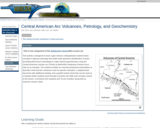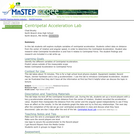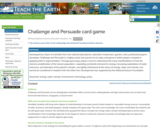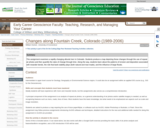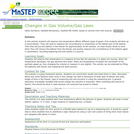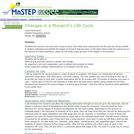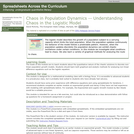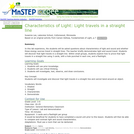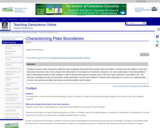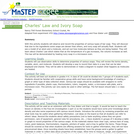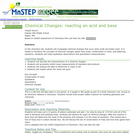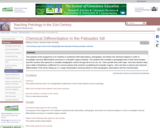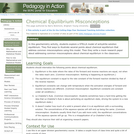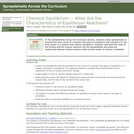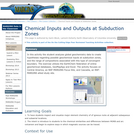To prepare for this exercise students read about the processes that operate at plate boundaries and how they are related to the distinct patterns of seismicity, volcanism, surface elevations (e.g., ridges versus trenches), and seafloor ages characteristic of different boundary types. During the week the assignment is available online, students have access to:
(1) an index map that locates three boundaries they are to study; and
(2) four maps from Sawyer's Discovering Plate Boundaries website that provide the data mentioned above.Â
Student tasks are to:Â
(1) document patterns in each type of data along the three targeted boundaries; andÂ
(2) use these observations in conjunction with their understandings of the processes that operate along different types of boundaries to decide whether each of the targeted sites is most likely to be a divergent, convergent, or shear boundary.Â
This activity gives students practice in map reading, interpreting the likely tectonic setting of a boundary by pulling together constraints from several types of data, and collaborating with their classmates in an online environment. The activity also provides a foundation for understanding a wide range of phenomena that are discussed later in the semester in the context of plate tectonic processes.
Modifications on this activity from the community
Show More
Show LessContributed by Tom Hickson
I also use a version of Dale Sawyer's Discovering Plate Boundaries exercise in an online course. I used the basic idea of this activity and moved in onto Canvas, our LMS. Here is my adaptation of the activity, with maps and examples, illustrating how I have implemented it:
Description of the assignment: Student handout, ONLINE_ Characterizing Plate Boundaries (adapted).pdf (Acrobat (PDF) 166kB Feb19 21)
Answer sheet for students to record observations and interpretations: Target Boundaries: Student answer sheet (Acrobat (PDF) 1MB Feb19 21)
World map with Target Boundaries (Acrobat (PDF) 483kB Feb19 21)
Maps of the "target boundaries" -- my selected areas of focus for the exercise:
Example map, Boundary 3
Provenance: Thomas A. Hickson, University of St. Thomas
Reuse: This item is offered under a Creative Commons Attribution-NonCommercial-ShareAlike license http://creativecommons.org/licenses/by-nc-sa/3.0/ You may reuse this item for non-commercial purposes as long as you provide attribution and offer any derivative works under a similar license.
Example map, Boundary 2
Provenance: Thomas A. Hickson, University of St. Thomas
Reuse: This item is offered under a Creative Commons Attribution-NonCommercial-ShareAlike license http://creativecommons.org/licenses/by-nc-sa/3.0/ You may reuse this item for non-commercial purposes as long as you provide attribution and offer any derivative works under a similar license.
Map example, boundary 1
Provenance: Thomas A. Hickson, University of St. Thomas
Reuse: This item is offered under a Creative Commons Attribution-NonCommercial-ShareAlike license http://creativecommons.org/licenses/by-nc-sa/3.0/ You may reuse this item for non-commercial purposes as long as you provide attribution and offer any derivative works under a similar license.
Teaching Tips
Adaptations that allow this activity to be successful in an online environment
Sawyer's Discovering Plate Boundaries is a jigsaw exercise in which students collaboratively develop an empirical classification of plate boundaries by first studying an individual data set (e.g., seismicity) and then working as part of a multidisciplinary team to develop a composite classification for the boundaries of a single plate using several types of data. In order for the classification to be truly empirical, students are not introduced to the "traditional" classification of plate boundaries till the end of the exercise.Â
In adapting this assignment to the online environment I have:
(1) asked students to prepare by becoming familiar with the standard classification of plate boundaries and the processes that operate at them;Â
(2) limited their work to three targeted boundaries of different types; andÂ
(3) provided guidance about which features to look for in the each data set. I have found that these modifications help online students, who often work alone "on their own schedules", to avoid getting "lost" and frustrated with the assignment and to compensate for the lack of collaborative input they would receive in a classroom setting.
Elements of this activity that are most effective
The success of this exercise is really seems to depend on how well a student follows the directions. If a student learns about the geologic differences among plate boundaries, makes careful observations, and thoughtfully compares his or her observations to the expected patterns he or she typically does quite well based on answers to the follow-up questions. If, on the other hand, a student simply looks up the types of the targeted boundaries on a map and then attempts to "back out" the observations that he or she thinks should fit, the result is often inconsistency and a poor score on the questions. (I can often tell which approach a student is taking based on the queries they post to the discussion board, but rarely seem to be able to get those who are trying to work backwards through the assignment to change direction.)
Recommendations for other faculty adapting this activity to their own course:
To date my experience developing an engaging online exercise to help students learn the principles of plate tectonics has only been partly successful. I think that having such an exercise is critical, however, because this topic provides the framework for so much of what we learn in the geosciences. Based on my efforts to adapt elements of Discovering Plate Boundaries to an online environment I would offer three recommendations.
(1) Provide examples. Confronted with an unfamiliar map students are sometimes confused when asked to decide if seafloor age, for example, is uniform or variable along the length of a boundary. Showing them what you mean using snapshots from a map can often clear questions like this up quickly. Similarly, for written work a single example that gives them a clear sense of "what you're looking for" and can often head off a lot of questions.
(2) Choose the boundaries you ask students to study carefully. The scarcity of documented volcanism along a mid-ocean ridge or the burial of seafloor age belts by sediment along a trench can result in student observations that are correct, but problematic for correctly assessing the nature of a boundary.
(3) Stay on top of student questions and comments, and be prepared to make well-publicized "mid-course corrections" if something you thought was clear turns out to be misunderstood. These minor corrections happen naturally in face-to-face classes but can require real diligence to catch and correct in the online environment.
(Note: this resource was added to OER Commons as part of a batch upload of over 2,200 records. If you notice an issue with the quality of the metadata, please let us know by using the 'report' button and we will flag it for consideration.)
